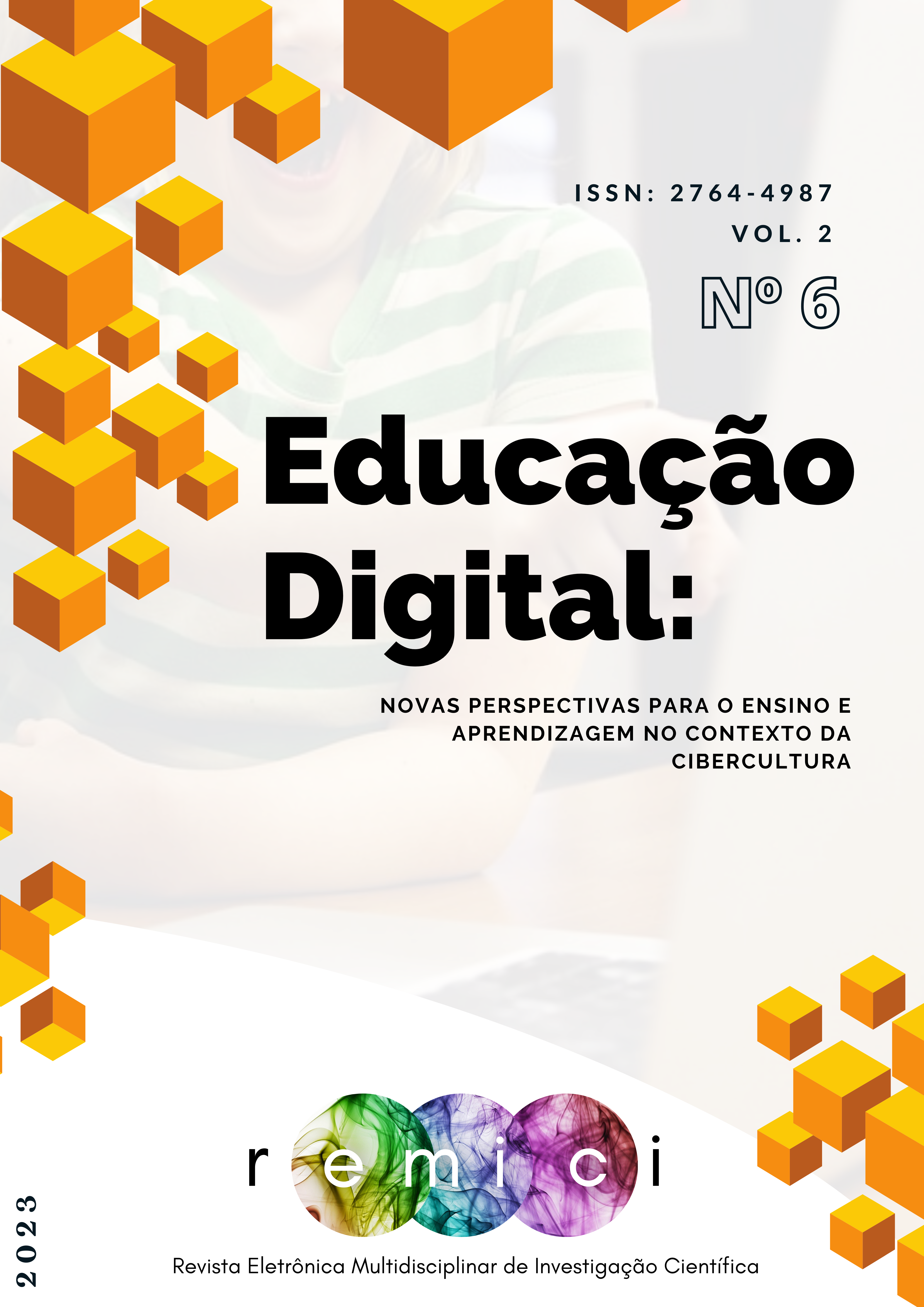Digital Technologies in Remote School Physical Education Classes During the COVID-19 Pandemic
Main Article Content
Abstract
This study has as its central theme the debate about digital technologies in remote School Physical Education classes, with the general objective of analyzing the increase in digital technologies in remote School Physical Education classes during the COVID-19 pandemic, and the specific objective of verifying the main adaptations in School Physical Education classes for the remote field. The methodology used was the Literature Review, based on the search for scientific articles in the Scielo and Periódicos CAPES databases published between 2020 and 2022, on the subject. After the analysis, it was found that in all the researched material, Physical Education teachers used social media as teaching and learning tools in the development of classes. In addition, the need for methodological adaptations by teachers was noticeable, due to social distancing. Thus, it is concluded that the studies pointed to the need to invest in continuing education, in order to offer quality education, due to the adversities of the COVID-19 Pandemic.
Keywords: Teaching; School Physical Education; Pandemic; Digital Technologies.
Article Details

This work is licensed under a Creative Commons Attribution-NonCommercial-ShareAlike 4.0 International License.
References
ARANTES, A. C. A História da Educação Física escolar no Brasil. Revista Digital, Buenos Aires, N° 124, 2008. Disponível em: <https://www.efdeportes.com/efd124/a-historia-da-educacao-fisica-escolar-no-brasil.htm>. Acesso em Dez. 2022.
ARAÚJO, A. C. de; OVENS, A. Distanciamento social e o ensino de Educação Física: estratégias, tecnologias e novos aprendizados. Movimento. Revista de Educação Física da UFRGS, Rio Grande do Norte, v. 28, Dec. 2022. Disponível em: < https://seer.ufrgs.br/index.php/Movimento/article/view/122671>. Acesso em Jan.2023.
BACICH, L.; MORAN, J. Metodologias ativas para uma educação inovadora. Porto Alegre: Penso, 2018.
BARBOSA, K. de A.; DAMASCENO, A. G.; ANTUNES, S. E. Educação física e pandemia: o que dizem alguns estudos sobre o ensino remoto de educação física na educação básica?. Caderno de Educação Física e Esporte, Marechal Cândido Rondon, v. 20,2022. Disponível em: < https://e-revista.unioeste.br/index.php/cadernoedfisica/article/view/27832>. Acesso em Jan.2023
BARROS, D. M. V.; ROMERO, C. S.; MOREIRA, J. A. Cenários Virtuais de Aprendizagem, colaboração e intercâmbio: a coaprendizagem como uma estratégia didático pedagógica. Revista Tempos e Espaços em Educação, Sergipe, v.7, 2014. Disponível em < https://seer.ufs.br/index.php/revtee/article/view/3453>. Acesso em Dez.2022.
BOKUMS, R. M.; MAIA, J. F. Educação a Distância (EaD) no Brasil: uma reflexão a respeito da inclusão social. Revista UnilaSalle. DiÁLOGO, Canoas, n. 38, p. 99-111, ago. 2018. Disponível em: https://revistas.unilasalle.edu.br/index.php/Dialogo/article/view/3994/pdf. Acesso em: 23 out. 2022.
BRASIL. Ministério da Educação. Base Nacional Comum Curricular. Brasília, 2018. Disponível em: http://basenacionalcomum.mec.gov.br/images/BNCC_EI_EF_110518_versaofinal_site.pdf. Acesso em: 30 set. 2022.
BRASIL. Ministério da Educação. Decreto Lei nº 58.130 de 31 de março de 1966. Diário Oficial da União. 20 de dezembro de 1961. Disponível em https://www2.camara.leg.br/legin/fed/decret/1960-1969/decreto-58130-31-marco-1966-398761-publicacaooriginal-1-pe.html. Acesso em: 29 set. 2022.
BRASIL. Ministério da Educação. Lei de Diretrizes e Bases. Lei nº 9.394/96 de 20 de dezembro de 1996. Disponível em: http://www.planalto.gov.br/ccivil_03/leis/l9394.htm. Acesso em: 29 set. 2022.
BRAZ, M. V. A pandemia de COVID-19 (SARS-COV-2) e as contradições do mundo do trabalho. Laborativa, Minas Gerais, Abr. 2020. Disponível em: < https://ojs.unesp.br/index.php/rlaborativa/article/view/3192>. Acesso em Dez.2022.
GODOI, M.; NOVELLI, F. I.; KAWASHIMA, L. B. Educação física, saúde e multiculturalismo em tempos de covid-19: uma experiência no ensino médio. Saúde e Sociedade [online]. 2021, v. 30, n. 3. Disponível em: https://www.scielo.br/j/sausoc/a/34tmNLV5Rf5db7xhxjwgKQm/# . Acesso em: 14 nov. 2022
LIBÂNEO, J. C. Didática. São Paulo: Cortez, 2013.
MINISTÉRIO DA EDUCAÇÃO E DO DESPORTO. Parâmetros curriculares Nacionais. Brasília: MEC/SEF, 1997.
MOISES, R. R.; LOPES, E. A Organização do Trabalho Didático da educação física em tempos de pandemia: alternativas inclusivas ante o isolamento social do estudante com deficiência. Caderno de Educação Física e Esporte, Paraná, v. 20, 2022. Disponível em: <https://e-revista.unioeste.br/index.php/cadernoedfisica/article/view/28986>. Acesso em Jan.2023.
MOREIRA, E. C.; PEREIRA, R. S. Desafios impostos às aulas de educação física na pandemia: caminhos para a ressignificação do trabalho docente. Caderno de Educação Física e Esporte, Paraná, v. 19, 2021. Disponível em: < https://e-revista.unioeste.br/index.php/cadernoedfisica/article/view/27461>. Acesso em Dez. 2022.
PACHECO, R. R.; ACCO, L. L. O Ensino Remoto na Educação Física Escolar em Tempos da Pandemia da Covid-19: Uma Pesquisa Bibliográfica. Animaeducação, Tubarão, p. 01-13, 09 dez. 2021. Disponível em: < https://repositorio.animaeducacao.com.br/bitstream/ANIMA/18811/4/O%20ENSINO%20REMOTO%20NA%20EDUCA%C3%87%C3%83O%20F%C3%8DSICA%20ESCOLAR%20EM%20TEMPOS%20DA%20PANDEMIA%20DA%20COVID19%20UMA%20PESQUISA%20BIBLIOGRAFICA.pdf>. Acesso em Dez.2022.
PARRIS, Z. et al. Atividade física para saúde, covid-19 e mídias sociais: o que, onde e por quê? Movimento, v. 28, jan./dez. 2022. Disponível em: < https://www.scielo.br/j/mov/a/djwsMRCPTM8f3BxBxXz6mcJ/>. Acesso em Dez.2022.
VYGOTSKY, L. S. A formação social da mente: o desenvolvimento dos processos superiores psicológicos. 7. ed. São Paulo: Martins Fontes, 2007. p.182.

